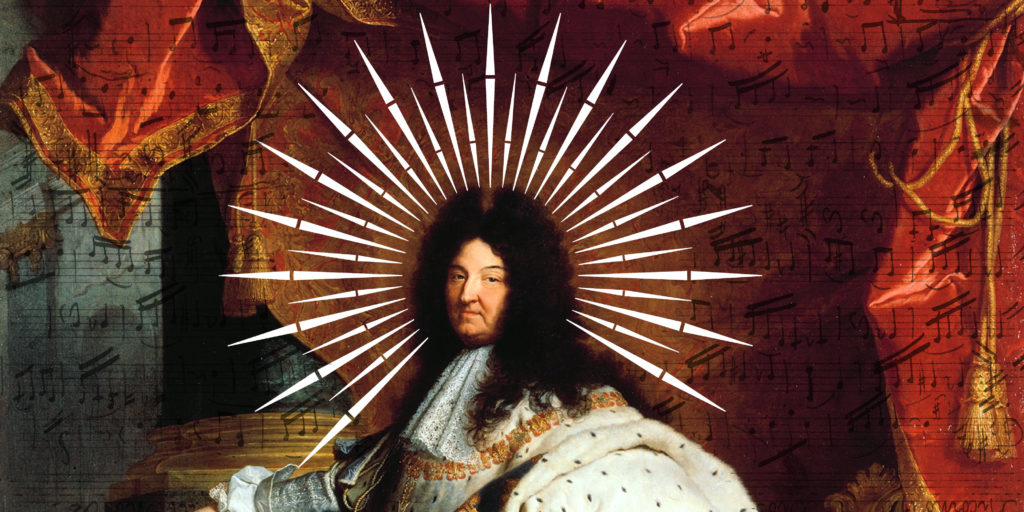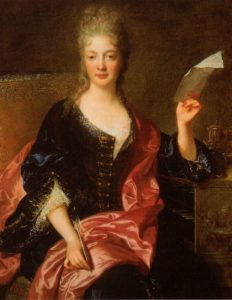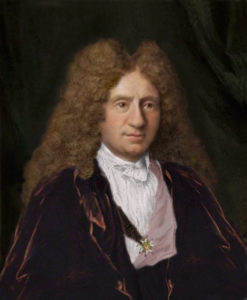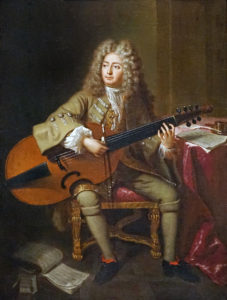During King Louis XivS Reign Which Work of Art Became a Symbol of Absoultism?

Kara McLeland 91Classical
On this day in 1682, Louis Xiv moved the French court and authorities to Versailles. The future French rex had first visited the holding to escape a smallpox epidemic when he was three years sometime, and over the form of his life he transformed the once-humble hunting gild into a palace, unprecedented in its extravagance and a symbol of full monarchy that would eventually topple during the French Revolution.
It wasn't only architectural excellence that Louis XIV was interested in; he was also a fervent fine art enthusiast. Robert Thousand. Isherwood, who was a professor of history at Vanderbilt University for nearly 30 years and the author of Music in the Service of the Male monarch: French republic in the Seventeenth Century, wrote this well-nigh Louis XIV'south artistic interests:
The male monarch earnestly wanted his reign to be famous for its creative luminescence, and he believed that musicians, poets, painters, sculptors, and architects could preserve his nifty deeds for posterity. Louis aspired non just to surpass the achievements of classical antiquity but to establish French republic's creative supremacy in Europe.
During Louis XIV's record 72-year reign, music flourished at Versailles. Hear some of that music below, and should you lot feel so inclined, take a virtual tour of the palace and several online exhibitions as yous listen.
Jean-Baptiste Lully (1632-1687)
 Brought from Florence to Paris equally a young male child to help a French noblewoman perfect her Italian, Jean-Baptiste Lully first met a young Louis Xiv when the two danced together in a ballet. They forged friendship that would issue in Lully spending most of his life working every bit Main of the King'southward Music. Considered the father of French opera, Lully composed Persée the same year Louis XIV moved to Versailles.
Brought from Florence to Paris equally a young male child to help a French noblewoman perfect her Italian, Jean-Baptiste Lully first met a young Louis Xiv when the two danced together in a ballet. They forged friendship that would issue in Lully spending most of his life working every bit Main of the King'southward Music. Considered the father of French opera, Lully composed Persée the same year Louis XIV moved to Versailles.
The opera was re-created almost a century later in 1770 when Louis XV completed the palace'southward Purple Opera Hall — a venue his great-grandad never finished. At the time, it was the largest concert hall in Europe, and Lully's opera would mark both its inauguration and the union of the Dauphin (the time to come Louis 16) to Marie Antoinette. The lavish performances included a 95-voice choir, 15 soloists, 80 dancers, 100 extras, fourscore instrumentalists, 5 sets, and 530 costumes.
Watch Lully expert Hervé Niquet and the ensemble Concert Spirituel recreate the music for a 2016 recording:
Élisabeth Jacquet de La Guerre (1665-1729)
 Jacquet de La Guerre earned the nickname "la petite merveille" (the small wonder) subsequently appearing every bit five-yr-former prodigy at the courtroom of Louis XIV, singing and playing harpsichord. After regular appearances, she was accustomed into the French court as a teenager, where Madame de Montespan, ane of Louis's mistresses, oversaw her musical education.
Jacquet de La Guerre earned the nickname "la petite merveille" (the small wonder) subsequently appearing every bit five-yr-former prodigy at the courtroom of Louis XIV, singing and playing harpsichord. After regular appearances, she was accustomed into the French court as a teenager, where Madame de Montespan, ane of Louis's mistresses, oversaw her musical education.
She composed some of her kickoff pieces at Versailles, spending a few years there earlier marrying organist Marin de la Guerre in 1684 and moving back to Paris. There, she taught lessons, composed, and performed concerts to dandy acclamation.
Below, the Bach Players perform her Sonata in D minor for violin, viola da gamba, and harpsichord:
François Couperin (1668-1733)
 In June of 1710, Louis XIV'southward final building project at Versailles—a chapel complete with a make new organ— was consecrated. The organ was inaugurated that same day by François Couperin, who at the time was ane of 4 court organists and harpsichord teacher to the royal children.
In June of 1710, Louis XIV'southward final building project at Versailles—a chapel complete with a make new organ— was consecrated. The organ was inaugurated that same day by François Couperin, who at the time was ane of 4 court organists and harpsichord teacher to the royal children.
And promotions soon followed: in 1713 he was given a xx-twelvemonth majestic privilege to publish, resulting in several volumes of keyboard works and chamber music, and in 1717 he was named courtroom harpsichordist. While he's best known for his harpsichord music, Couperin likewise penned notable chamber works, including the Concerts royauxhe composed for the king'due south Sunday evening entertainments:
Marc-Antoine Charpentier (1643-1704)
 Charpentier'south fashion into Louis XIV'southward courtroom wasn't like shooting fish in a barrel, cheers to a rivalry with leading royal composer Jean-Baptiste Lully. Charpentier'due south patroness, the influential Mademoiselle Marie de Lorraine, Duchess of Guise, introduced him into French high order. Eventually, his music defenseless the ear of of the Rex, which sparked the jealously of Lully, who did his best to ensure that Charpentier would never get a imperial engagement.
Charpentier'south fashion into Louis XIV'southward courtroom wasn't like shooting fish in a barrel, cheers to a rivalry with leading royal composer Jean-Baptiste Lully. Charpentier'due south patroness, the influential Mademoiselle Marie de Lorraine, Duchess of Guise, introduced him into French high order. Eventually, his music defenseless the ear of of the Rex, which sparked the jealously of Lully, who did his best to ensure that Charpentier would never get a imperial engagement.
Beyond that, Lully'southward imperial privilege essentially granted him a monopoly on staging big-scale opera in France, so Charpentier turned his focus to sacred vocal music, composing for the Jesuits, and staging the occasional chamber opera in the dwelling house of his patroness. Somewhen he earned several royal positions: Main of Music at the Sainte-Chapelle, the king's private chapel in Paris, and composer for the individual masses of the Dauphin, the king's eldest son.
While in this position, Charpentier snuck in a few of his operas at court, including one that must have been flattering to his patrons: The Pleasures of Versailles. In it, the characters stand for the many indulgences that were abundant at the palace, including music, chat, and gambling.
Michel Richard Delalande (1657-1726)
 A competition in 1683 brought Delalande to the court of Louis Fourteen. The rex had asked 15 composers to set the words of the psalm "Beati quorum," and Delalande's success marked the first of his xl years in service at the court. As ane of the rex's favorite musicians, Delalande worked as a composer, organist, and music teacher for the imperial daughters.
A competition in 1683 brought Delalande to the court of Louis Fourteen. The rex had asked 15 composers to set the words of the psalm "Beati quorum," and Delalande's success marked the first of his xl years in service at the court. As ane of the rex's favorite musicians, Delalande worked as a composer, organist, and music teacher for the imperial daughters.
He's mostly known for writing grand motets, a sacred genre that fabricated use of large choirs and an orchestra, and Symphonies pour les Soupers du Roy, music written to accompany the king'south meals—which were, similar near things associated with Louis 14, a grand public spectacle.
Marin Marais (1656-1728)
 A student of Lully and a virtuoso on the viola da gamba, Marin Marais was hired every bit a court musician in 1676 and was soon thereafter promoted to Violist for the King, a position he held until his retirement in 1725. He is, of form, remembered for his hundreds of composition for various instruments of the viol family, merely he likewise equanimous several operas at the encouragement of his instructor.
A student of Lully and a virtuoso on the viola da gamba, Marin Marais was hired every bit a court musician in 1676 and was soon thereafter promoted to Violist for the King, a position he held until his retirement in 1725. He is, of form, remembered for his hundreds of composition for various instruments of the viol family, merely he likewise equanimous several operas at the encouragement of his instructor.
Marais often gave his pieces descriptive, colorful titles, and sometimes penned programmatic music— one memorable case being Tableau de l'Opération de la Taille, an artistic depiction of a risky surgery he endured at historic period 64 to remove a rock from his float.
Melody in to 91Classical all solar day today to hear music from King Louis XIV's court at Versailles.
Source: https://91classical.org/post/songs-for-the-sun-king-music-from-louis-xivs-court-at-versailles/
0 Response to "During King Louis XivS Reign Which Work of Art Became a Symbol of Absoultism?"
Post a Comment